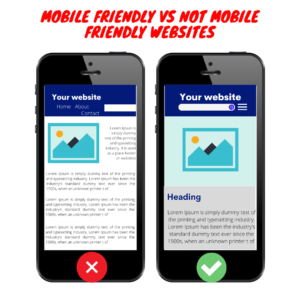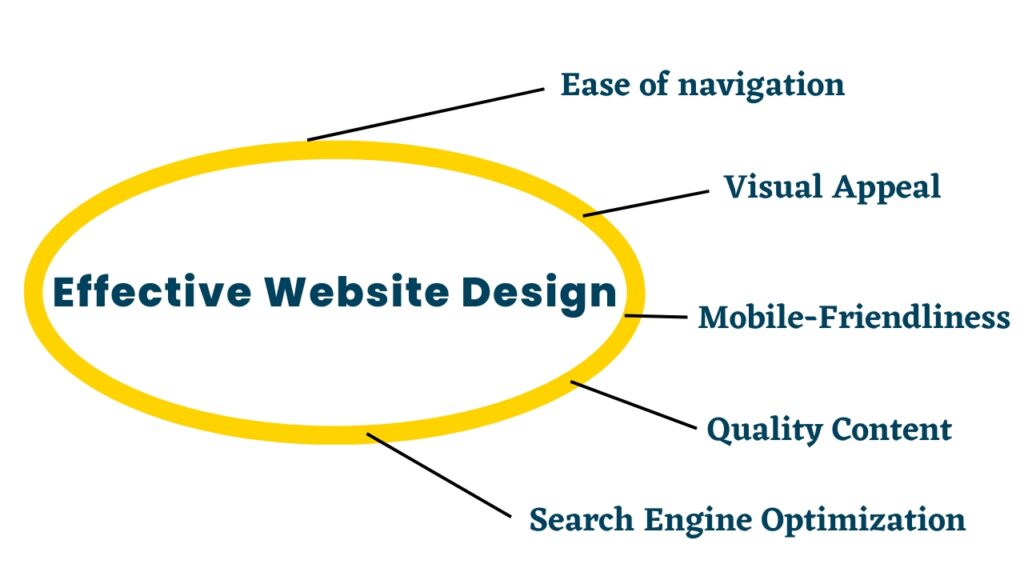Having an effective website design is key to providing an engaging and positive user experience. Whether you’re a business, organization, or individual, your website should be designed with the user in mind. In this post, we’ll explore five elements of effective website design and discuss why each element is important. From user-friendly navigation to utilizing visuals, we’ll discuss the importance of each element and how it ties into the overall design of your website. So, let’s get started and dive into the five elements of effective website design.
Effective website design should include the following five elements:
5) Search engine optimization (SEO)
When each of these elements is thoughtfully balanced, it can help create a cohesive user experience that meets the needs of your audience.
1) Ease of Navigation

The importance of ease of navigation in effective website design cannot be overstated. A website’s navigation should be intuitive and easy to use. Allowing users to access the content they are looking for quickly and easily. This helps foster a positive user experience, which can lead to increased conversions and website visits.
By providing clear menus, labels, and links, visitors will be more likely to stay on your website and find the information they need. Additionally, having an easy-to-use navigation system can help improve your overall website performance and reduce the time it takes visitors to complete their desired tasks.
An example of a website that is easy to navigate is Amazon.com. It has an intuitive layout and a search bar at the top of the page to help you quickly find what you’re looking for. On the other hand, a website that is not so easy to navigate is craigslist. The website has a lot of different sections, and it can be difficult to find the specific item you’re looking for.
2) Visual Appeal
Visual appeal refers to the overall aesthetics of a website’s design. This includes the colors, layout, typography, and imagery used. It’s important to have a visually appealing design for your website because it can help create a strong impression on potential visitors. A visually appealing website also helps draw users’ attention to important parts of your website and can help create a more user-friendly experience.
In addition, good visual design can make conveying a website’s message easier. Effectively helping to create a sense of trust between your website and visitors. Overall, a visually appealing website is key to creating an effective website design that will attract and retain visitors.
A great example of a visually appealing website is Pinterest.com. It features a minimalist design, where the images are the main focus. Also, the interface is clean and organized, with simple navigation, allowing the user to easily find what they are looking for. The bright and vibrant colors give it a modern and inviting feel. The typography is easy to read, and the buttons are clearly labeled.

3) Mobile-friendliness
Effective website design
A mobile-friendly website design is one that is optimized for mobile devices such as smartphones and tablets. This usually means that the website’s layout and content are adjusted to look great and work well on mobile devices. On the other hand, a website that is not mobile-friendly will look and feel awkward or clunky. That’s because it was only designed for desktop computers and not mobile devices.

The importance of mobile-friendliness in effective website design is that it ensures visitors have a good user experience when visiting on their mobile devices. This can help to increase engagement, traffic, and conversions on the website. While also improving the overall reputation of the website.
An example of a mobile-friendly website is one that has simplified navigation and larger, easier-to-tap buttons. While an example of a website that is not mobile-friendly is one that has a lot of text and small links that are difficult to click on a mobile device. See examples above.
4) Quality Content

Quality content is well-written, relevant, and engaging. It should be informative, helpful, and easily understandable. Ultimately quality content helps to attract visitors to your website and is important for effective website design. Because good content will influence visitors to stay and explore your website, as it helps to keep them engaged and interested. Quality content is well-written, relevant, and engaging. It should be informative, helpful, and easily understandable.
Ultimately quality content helps to attract visitors to your website and is important for effective website design. Because good content will influence visitors to stay and explore your website longer. As it helps to keep them both engaged and interested.
Quality content also helps to create brand awareness, because it helps to build trust and credibility with potential customers. Furthermore, quality content can help to rank your website higher in search engine results. It’s well known that search engines prefer websites with high-quality content. Especially unique informative content that addresses a visitor’s issue, solves their problem or teaches them how to achieve a result.
5) Search Engine Optimization
SEO stands for Search Engine Optimization and refers to techniques used to increase the visibility of a website in search engine results pages. SEO techniques involve optimizing your website’s content, structure, and design to make it easier for search engines to read and understand the content.
The importance of SEO in effective website design is to ensure the website is optimized for search engines. So that when someone searches for related topics, the website will appear in the search results. SEO also helps to improve website usability. Which is important for providing a good user experience for visitors and encouraging them to stay on the website for longer.
The most popular search engines are Google, Bing, and Yahoo. To rank higher on search engines, you should focus on optimizing your website content with relevant keywords. Creating backlinks from high-quality websites and using social media to drive traffic to your pages. Additionally, you should ensure your website is mobile-friendly, as this is an important factor in how search engines rank websites.
Conclusion
All five elements of effective website design are critical in ensuring that visitors have a positive experience on your website. Ease of navigation helps visitors find what they are looking for quickly and easily. While visual appeal captures their attention and encourages them to explore further. Mobile-friendliness ensures that visitors can view the website on their preferred device, and quality content provides useful information. Lastly, SEO ensures that the website can be found in search engine results. When these five elements are implemented effectively, your website will have a powerful impact on visitors.




